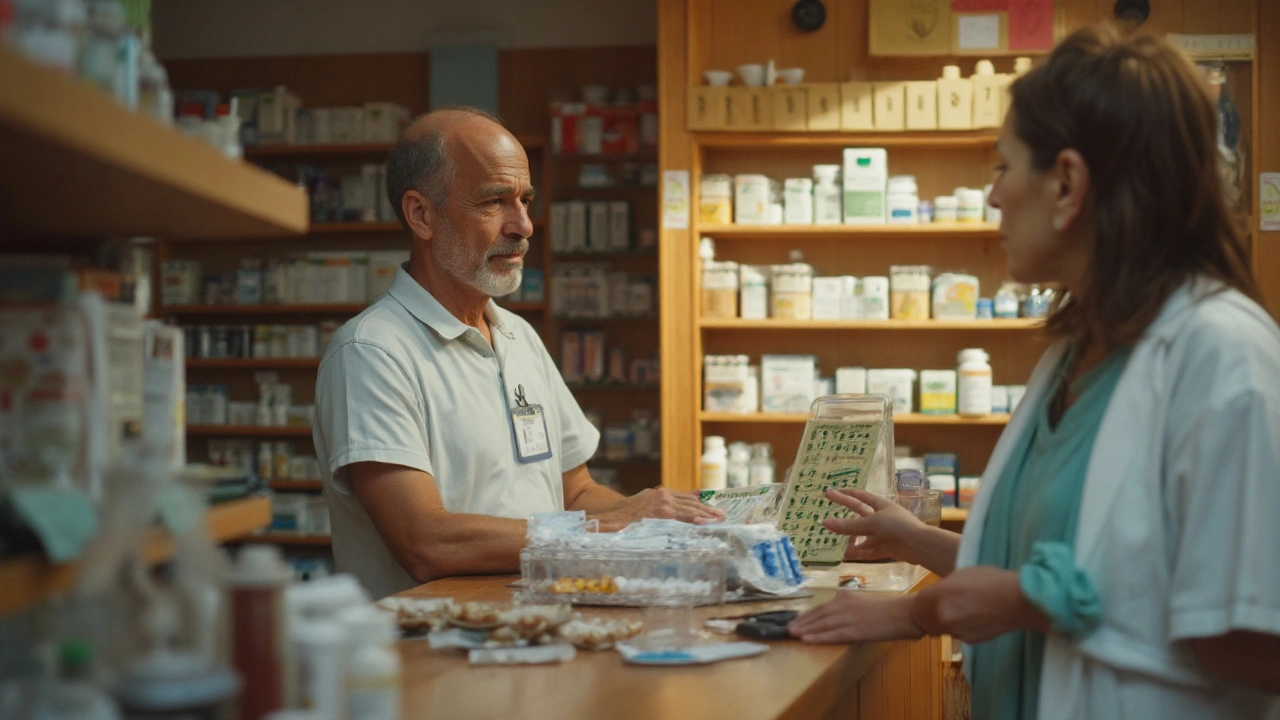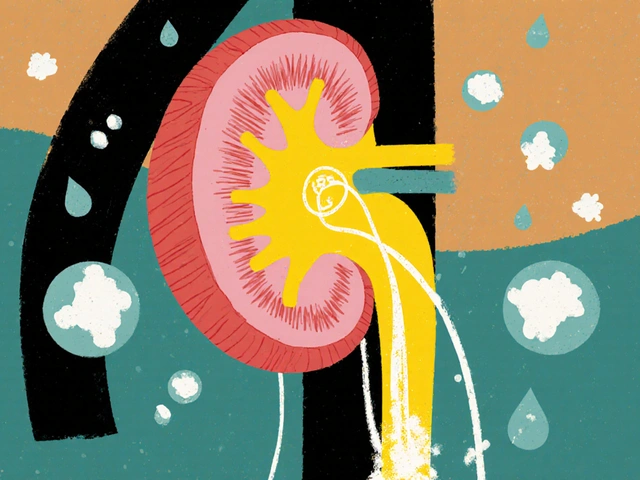Griseofulvin vs Other Antifungals: Best Uses, Safety, and Cure Rates
You’ve got a stubborn fungal infection and a short list of meds that all sound similar. The catch? They’re not. Griseofulvin shines in a few spots, falls short in others, and the same goes for terbinafine, itraconazole, fluconazole, and topicals. The right pick depends on the body site, the exact fungus, how quickly you want results, and your health profile. I’ll lay out how to choose-and when griseofulvin is smart, and when it isn’t.
- Griseofulvin is great for scalp ringworm in kids (especially Microsporum) but loses to terbinafine for most nail infections.
- For nails (onychomycosis), terbinafine usually wins on cure rates and speed; itraconazole is plan B; fluconazole is slower, off‑label in many regions.
- Most skin ringworm clears with topicals; save oral meds for widespread, inflamed, or hair/scalp/nail disease.
- Safety matters: griseofulvin and azoles can interact with other meds; terbinafine needs liver checks, especially for longer courses.
- Match the drug to the bug and body site, not just the name on the bottle. Culture or KOH helps when the diagnosis is iffy or treatment fails.
How to choose the right antifungal: the decision criteria that matter
Start with the target. Griseofulvin works on dermatophytes (Trichophyton, Microsporum, Epidermophyton). It doesn’t treat Candida or Malassezia. Azoles (like itraconazole and fluconazole) cover Candida. Terbinafine is strong against dermatophytes, weaker for Candida. That match-up is your first filter.
Next, the body site:
- Skin (tinea corporis, cruris, pedis): Usually topical first. Oral if severe, widespread, or failed topicals.
- Scalp (tinea capitis): Needs oral therapy. Kids often do well with griseofulvin; terbinafine is preferred for many Trichophyton infections.
- Nails (onychomycosis): Oral therapy is the mainstay. Terbinafine beats griseofulvin in most adult nail infections.
- Yeast (Candida) rashes: Azoles (topical or oral) are the right family; griseofulvin won’t help.
Speed and cure rates: For most adult nail infections, terbinafine gives the highest complete cure rates and shorter courses. Itraconazole is next. Griseofulvin is slower and less reliable for nails, but it still has a role in select scalp infections. Topicals are fast for simple skin ringworm and avoid systemic side effects.
Safety and interactions:
- Griseofulvin: Can lower warfarin effect and reduce hormonal contraceptive effectiveness. Photosensitivity and headache are common. Avoid in pregnancy.
- Terbinafine: Rare liver injury; baseline liver enzymes are standard before nail courses. Taste changes can happen but usually resolve.
- Itraconazole: Lots of drug-drug interactions (CYP3A4). Avoid in heart failure. Some forms need stomach acid for absorption.
- Fluconazole: Fewer interactions than itraconazole, but still meaningful (e.g., warfarin). Off‑label for nails in many places.
Practical stuff: Can you take pills daily for weeks to months? Do you have liver disease? Are you pregnant or trying to conceive? What’s covered by your insurance? These real‑world guardrails often make the decision for you.
Credibility check: Recommendations below align with dermatology and infectious disease guidance from the American Academy of Dermatology, the Infectious Diseases Society of America, FDA labeling updates through 2024, and systematic reviews, including Cochrane analyses published in the last few years.
Griseofulvin vs. terbinafine, itraconazole, fluconazole, and topicals: head‑to‑head
If you’re comparing options for nails or scalp, the most searched matchup is griseofulvin vs terbinafine. Here’s how the common choices stack up for typical problems.
| Medication | Works best for | Usually avoid / less effective for | Typical adult duration | Complete cure rate (range)* | Common issues | Big interactions / warnings | Notes |
|---|---|---|---|---|---|---|---|
| Griseofulvin (oral) | Tinea capitis (esp. Microsporum in kids); dermatophyte skin when oral needed | Onychomycosis in adults; Candida/Malassezia | 6-12 weeks (scalp); months for nails | Scalp: high; Nails: low to modest | Headache, GI upset, photosensitivity | Enzyme inducer: lowers warfarin and some contraceptives; avoid in pregnancy | Take with fatty meal to boost absorption |
| Terbinafine (oral) | Onychomycosis (dermatophyte); tinea capitis (Trichophyton) | Candida infections | 6 wks (fingernails), 12 wks (toenails); 4 wks (scalp) | Nails: moderate to high vs others | GI upset, taste/odor changes, rash | Rare hepatotoxicity; baseline LFTs; caution with CYP2D6 substrates | Often first‑line for adult nails |
| Itraconazole (oral) | Onychomycosis (alt), some non‑dermatophyte molds; refractory tinea | Heart failure; many drug interactions | Pulse or continuous regimens for nails | Nails: moderate | Edema, GI upset | Strong CYP3A4 interactions; avoid with certain statins/benzos; warning in heart failure | Capsules need acid; solution doesn’t |
| Fluconazole (oral) | Candida skin/yeast; off‑label nails; recurrent tinea when others not tolerated | Dermatophyte nails (less robust than terbinafine) | Weekly dosing for months (nails) | Nails: low to moderate | Headache, GI upset | Warfarin and other CYP interactions; avoid high‑dose in pregnancy | Convenient weekly dosing |
| Topical azoles/allylamines | Skin ringworm (body, groin, foot) without hair/nail involvement | Scalp and nail disease | 1-4 weeks typically | Skin: high when used properly | Local irritation | Minimal systemic risk | First‑line for most skin tinea |
*Cure rates vary by study design, organism, and follow‑up. Meta‑analyses consistently show higher complete cure for terbinafine than itraconazole for toenails; griseofulvin is inferior for adult nails. Sources include Cochrane reviews (2017-2021 updates), AAD guidance (2020), IDSA practice guidance, and FDA labeling.
Key takeaways from the numbers: If it’s an adult with thick, slow‑growing toenails infected by a dermatophyte, terbinafine usually gives the best odds in the shortest time. If it’s a child with scalp ringworm-especially from Microsporum-griseofulvin is a time‑tested first pick. For Candida folds or thrush‑like rashes, an azole (topical or fluconazole) is the right family.

Best for / not for: real‑world scenarios and trade‑offs
Match the med to the scenario. Here’s how that looks in everyday cases.
- Tinea corporis (ringworm on body):
- Best: Topical terbinafine or clotrimazole for 2-4 weeks.
- Use oral (griseofulvin, terbinafine, itraconazole) if widespread, inflamed (Majocchi granuloma), or failed topicals.
- Tinea cruris (jock itch):
- Best: Topicals first. Add oral if severe or recurrent.
- Tinea pedis (athlete’s foot):
- Best: Topicals; oral if moccasin‑type or recurrent.
- Tinea capitis (scalp ringworm):
- Best: Oral therapy required. Griseofulvin for Microsporum; terbinafine for Trichophyton. If the species isn’t known, choose based on local patterns or use griseofulvin when gray‑patch/fluorescent woods lamp suggests Microsporum.
- Add selenium sulfide or ketoconazole shampoo 2-3x/week to lower spread.
- Onychomycosis (nail fungus):
- Best: Terbinafine for dermatophyte nails (12 weeks toes, 6 weeks fingers).
- Consider itraconazole for non‑dermatophyte molds or when terbinafine isn’t tolerated.
- Fluconazole is an off‑label alternative with weekly dosing; slower response.
- Griseofulvin: Usually not favored for adult nails due to lower success and long courses.
- Candida intertrigo/yeast rashes:
- Best: Topical azoles or nystatin; oral fluconazole for tough cases.
- Griseofulvin: Not effective.
Quick decision tree you can use with your clinician:
- If it’s skin only and not severe → use a topical first.
- If it’s scalp → pick griseofulvin (Microsporum) or terbinafine (Trichophyton); add antifungal shampoo to cut contagious spores.
- If it’s nails and it’s clearly a dermatophyte → oral terbinafine unless contraindicated.
- If culture shows Candida → pivot to an azole (topical or fluconazole).
- If you take lots of meds or have heart failure → avoid itraconazole; check interactions before azoles.
- If you’re pregnant or trying to conceive → avoid systemic antifungals; talk to your OB/dermatologist.
Trade‑offs you actually feel:
- Speed vs safety: Oral agents clear nails faster but carry lab monitoring and interaction baggage. Topicals are safer but slow or ineffective for nails/scalp.
- Cost vs convenience: Weekly fluconazole is convenient but slower; terbinafine is daily yet typically shorter total time. Griseofulvin often needs a fatty meal and longer courses.
- Certainty vs flexibility: A KOH or culture gives clarity and can save months of the wrong therapy. If you can’t test, pick the drug that best fits the likely organism at that body site.
Evidence notes: U.S. and European guidance and multiple RCTs back terbinafine’s edge in dermatophyte onychomycosis, especially toenails. Pediatric scalp data continue to support griseofulvin for Microsporum, while terbinafine is often better for Trichophyton. These patterns show up across AAD statements, IDSA guides, FDA labels, and Cochrane reviews (2017-2021).
Safety, side effects, and monitoring: what to expect
Oral antifungals are safe for most people, but they’re not vitamin gummies. Know the watch‑outs.
Griseofulvin:
- Common: Headache, nausea, photosensitivity. Take with a fatty meal to boost absorption and reduce stomach upset.
- Interactions: Can reduce warfarin effect and hormonal contraceptive reliability; consider backup contraception. Check other meds with your pharmacist.
- Monitoring: Baseline liver enzymes if you’ll be on it for weeks, or if you have liver disease. Stop and call your clinician if you see dark urine, jaundice, severe rash.
- Pregnancy: Avoid. Discuss timing if you or your partner are planning pregnancy.
Terbinafine:
- Common: GI upset, rash. Less commonly, taste or smell changes that usually resolve after stopping.
- Liver: Rare but serious liver injury has been reported. Baseline liver enzymes are standard for nail courses; repeat if you develop symptoms (fatigue, dark urine, abdominal pain, jaundice).
- Interactions: Affects CYP2D6; check antidepressants, beta‑blockers, and others on that pathway.
Itraconazole:
- Interactions: Strong CYP3A4 inhibitor-major interactions with certain statins, benzodiazepines, antiarrhythmics.
- Heart: Avoid in heart failure (negative inotrope).
- Absorption: Capsules need acid; PPIs/H2 blockers can reduce uptake. Solution bypasses this but tastes rough.
Fluconazole:
- Interactions: Increases warfarin effect; check INR. Also interacts with sulfonylureas and others.
- Pregnancy: Avoid prolonged/high‑dose regimens. One‑off low doses for vaginal candidiasis follow different risk guidance; confirm with your OB.
Topicals:
- Local: Irritation or mild burning at the site. Rare allergy.
- Adherence: Don’t under‑dose. Twice daily means twice daily, and keep going 1-2 weeks past clear skin to prevent relapse.
Quick safety checklist before you start:
- Confirm the infection type (KOH/culture if unclear or if prior treatment failed).
- Review meds for interactions (warfarin, contraceptives, cardio meds, psych meds).
- Get baseline liver enzymes for oral courses longer than a couple of weeks, especially for nails.
- Plan adherence: daily dose with food (griseofulvin), daily dose any time (terbinafine), or weekly (fluconazole) and set reminders.
- Hygiene plan: treat shoes/socks, clippers, pillowcases; add antifungal shampoo if scalp is involved.

Your next steps, quick answers, and troubleshooting
Mini‑FAQ
- How long until I see results? Skin: often within 1-2 weeks on topicals if you’re consistent. Scalp: several weeks. Nails: improvement shows as new healthy growth-6-12 weeks for the drug, 6-12 months for the nail to fully grow out.
- Do I always need a culture? Not for simple skin ringworm. For scalp and nails-or if you’ve failed therapy-KOH or culture makes the choice smarter and can catch yeast or non‑dermatophyte molds.
- Can I switch mid‑course? Yes, especially if you’re not responding or the lab shows a different organism. Discuss washout and interactions with your prescriber.
- Will topicals alone fix nail fungus? Usually no. They can help as add‑ons or for very mild disease, but oral therapy is the main driver for most nails.
- What about recurrence? Reinfection is common. Clean or replace nail tools, wash socks hot, spray shoes, and consider antifungal powders. For scalp, check close contacts and pets if Microsporum is suspected.
Next steps (by situation)
- Uncomplicated skin ringworm: Start a topical (terbinafine or clotrimazole) twice daily for 2-4 weeks. Keep going 1 week after clear skin.
- Scalp ringworm in a child: See a clinician for oral therapy. Ask whether local strains are Microsporum or Trichophyton dominant to guide the choice between griseofulvin and terbinafine. Add selenium sulfide shampoo 2-3x/week.
- Thick, crumbly toenails: Ask for KOH/culture if available. If it’s a dermatophyte, discuss terbinafine with baseline liver labs. If you take many interacting meds or have liver issues, talk alternatives like itraconazole pulse or topical adjuncts.
- Yeast skin folds: Use topical azole or nystatin; keep the area dry and use barrier creams. Consider fluconazole for stubborn cases.
Troubleshooting
- No change after 2-3 weeks on topical skin therapy: Confirm the diagnosis (eczema, psoriasis, or bacterial infection can mimic ringworm). Do KOH/culture and consider oral therapy.
- Worsening on griseofulvin: If it’s Candida or Malassezia, griseofulvin won’t help-switch families.
- Side effects on terbinafine: If you notice taste loss, rash, dark urine, or jaundice, stop and call your clinician. Switching to an azole may be reasonable after evaluation.
- Drug interactions with azoles: If you’re on warfarin, certain statins, or antiarrhythmics, ask for an interaction check and monitoring plan or choose a different agent.
Why you can trust these picks: The patterns here reflect FDA labeling through 2024, AAD and IDSA guidance used in clinics, and pooled results from randomized trials summarized in Cochrane reviews (2017-2021). Those sources consistently rank terbinafine highest for dermatophyte nail cure, favor griseofulvin for Microsporum scalp infections in kids, and reserve azoles for Candida or when terbinafine isn’t suitable.
Bottom line: pick the med that matches your organism and body site, fits your health profile, and that you can stick with. If that’s griseofulvin for a Microsporum scalp infection-perfect. If it’s terbinafine for thick, slow toenails-go with the evidence. And if you’re unsure, a quick KOH or culture can save months of trial and error.






16 Comments
Zachary Blackwell
September 2 2025Yo, have you ever wondered why big pharma pushes griseofulvin like it’s the holy grail while quietly burying the real data on terbinafine? It feels like they’re feeding us a script to keep the market saturated, especially when you look at the hidden patent extensions. The whole thing smells like a covert operation to keep cheaper, more effective drugs off the shelves. I’m not saying it’s a grand conspiracy, but the pattern is too consistent to ignore. Keep your eyes open, friends.
prithi mallick
September 2 2025i totally get where you're comign from, it can be overwhelming reading through all these meds. just remember that the best choice is still the one your doc tailors to you. stay safe and keep asking questions!
Michaela Dixon
September 2 2025Alright, let me unpack this antifungal jungle for you in a way that feels like a slow‑cooked story, because the nuances are worth a dozen breath‑taking sentences. First, griseofulvin, the old‑school champion, shines when Microsporum struts its stuff on a child's scalp – it’s like the vintage vinyl of antifungals, reliable but a bit bulky. Then you have terbinafine, the sprinter, racing through nail plates with cure rates that make the competition look like they’re walking in slow motion; its mechanism attacks the fungal cell membrane, a true assassin for dermatophytes. Itraconazole, the chameleon, can change its shape to tackle non‑dermatophyte molds, but it brings a carnival of drug–drug interactions, so you need a pharmacist on standby. Fluconazole, the diplomatic envoy, whispers sweet nothings to Candida, yet it flirts with the notion of off‑label nail use, which is like borrowing a neighbor’s lawn mower without asking. Topicals, those front‑line foot soldiers, zip right into skin tinea, clearing the battlefield within weeks, but they surrender their kingdom when the infection tries to hide in hair follicles or nail beds. Safety, dear reader, is the unsung hero; griseofulvin can sabotage birth control and flirt with warfarin, while terbinafine occasionally throws a liver‑related curveball that demands baseline labs. Itraconazole’s love affair with CYP3A4 is a drama that could end in a heart‑failure tragedy if you’re not careful. Fluconazole’s interactions are quieter but still present, especially with anticoagulants, and its pregnancy warnings are a reminder that not all heroes wear capes. The decision tree, when you finally lay it out, is essentially a match‑making service: identify the organism, locate the battlefield, check the patient’s comorbidities, and then pick the drug that best fits the romance. If you’re a teen with scalp ringworm caused by Microsporum, griseofulvin is your reliable date; if you’re an adult battling stubborn toenail fungus, terbinafine is the charismatic partner who will stick around for the full 12‑week courtship. Remember the KOH or culture test is the match‑maker’s questionnaire – skip it and you might end up with a disastrous blind date. Lastly, the insurance labyrinth can be the ultimate gatekeeper, deciding whether your chosen champion gets a green light or is left in the waiting room. In the end, the best antifungal isn’t a one‑size‑fits‑all; it’s the one that aligns with the fungus’s identity, the infection’s territory, and your personal health saga. Choose wisely, and may your skin, hair, and nails live happily ever after.
Dan Danuts
September 2 2025Great overview! If you’re feeling stuck, just remember you’ve got a community behind you-let’s tackle this together!
Dante Russello
September 2 2025Indeed, the therapeutic landscape is rich, diverse, and, frankly, quite nuanced; when we consider the pharmacodynamics, the side‑effect profile, and the patient’s comorbid conditions, a tailored approach becomes paramount; for instance, while griseofulvin offers a favorable safety margin in pediatric scalp ringworm, its limited efficacy in onychomycosis cannot be overlooked; conversely, terbinafine boasts superior cure rates in adult nail infections, yet necessitates periodic hepatic monitoring; therefore, a clinician must weigh these variables carefully, integrating laboratory data, drug‑interaction potential, and patient adherence factors to optimize outcomes; ultimately, shared decision‑making remains the cornerstone of effective antifungal therapy.
James Gray
September 2 2025Yo, just a heads up – griseofulvin can be a bit of a pain, like it takes forever to work, especially if u got nail fungus, so maybe check with ur doc if u want a faster fix lol.
Scott Ring
September 2 2025Hey all, just wanted to add that staying consistent with whichever treatment you pick is key – whether it’s a daily tablet or a twice‑daily cream, sticking to the schedule really boosts your chances of clearing the infection.
Shubhi Sahni
September 2 2025Absolutely, consistency is vital, and don’t forget to pair oral therapy with good hygiene practices – clean your socks, shoes, and bedding regularly, as reinfection is a common pitfall.
Danielle St. Marie
September 2 2025🤔💊 Honestly, if you’re still using griseofulvin for adult nail fungus, you’re basically playing a losing game – modern meds have left that dinosaur in the dust. 🚀🔥
keerthi yeligay
September 2 2025Pick the drug that fits the fungus and site – simple as that.
Peter Richmond
September 2 2025In summary, aligning the antifungal choice with the specific organism, anatomical location, and patient health profile is essential for optimal outcomes.
Bonnie Lin
September 2 2025Match the med to the bug and site for best results.
sara fanisha
September 2 2025Good luck!
Tristram Torres
September 2 2025The article is fine, but it feels like a generic list without real insight.
Jinny Shin
September 2 2025Wow, this read was like watching a slow drama unfold – the tension between old‑school griseofulvin and the flashy newcomers was palpable, and I could almost hear the whisper of lab results in the background. The way the author layered safety concerns with efficacy felt like a finely choreographed dance, each step measured, each pause deliberate, like a seasoned conductor guiding an orchestra of antifungal agents. It’s rare to see such a comprehensive, yet readable, dissection of the fungal battlefield – truly a performance worth a standing ovation.
deepak tanwar
September 2 2025While the comparison is thorough, I contend that the emphasis on terbinafine overlooks certain patient populations where its hepatic risks are non‑trivial; a more balanced appraisal would include those concerns prominently.